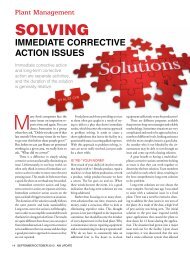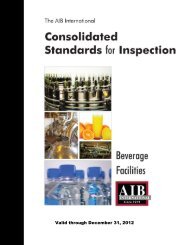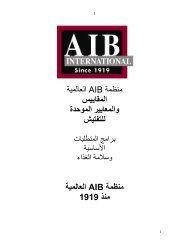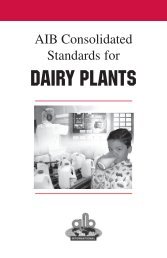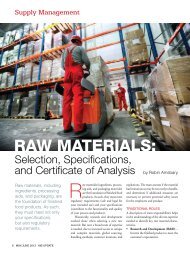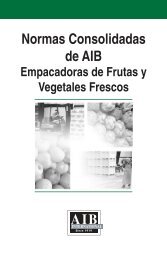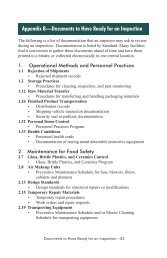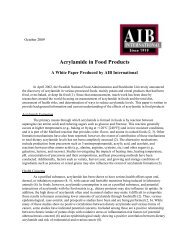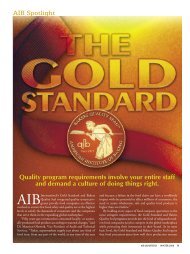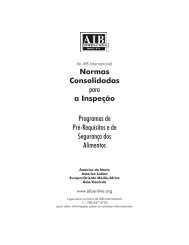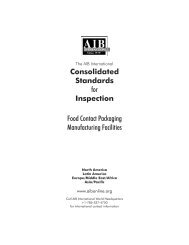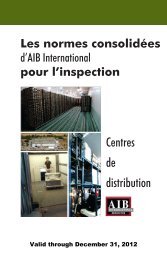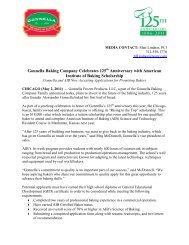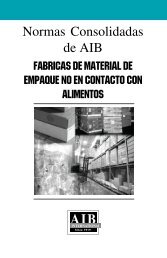Consolidated Standards for Inspection Food Distribution Centers
Consolidated Standards for Inspection Food Distribution Centers
Consolidated Standards for Inspection Food Distribution Centers
Create successful ePaper yourself
Turn your PDF publications into a flip-book with our unique Google optimized e-Paper software.
1.4 Storage Conditions<br />
Raw materials and fi nished products are stored in a clean storage area to protect them from contamination sources.<br />
Critical Requirements<br />
1.4.1.1 Storage areas are clean, well ventilated, and dry. Raw materials, work-in-process, packaging materials, and<br />
fi nished products are protected from condensate, sewage, dust, dirt, chemicals, or other contaminants.<br />
� Ө<br />
1.4.1.3 All toxic chemicals, including cleaning and maintenance compounds, and non-product materials, including<br />
equipment and utensils, are stored in a separate area.<br />
1.4.1.4 Research and Development items and infrequently used raw materials, packaging supplies, and fi nished<br />
products are regularly inspected <strong>for</strong> signs of infestation.<br />
1.4.1.5 Special handling procedures are followed <strong>for</strong> packaging materials that pose a product safety risk if<br />
mishandled (e.g., aseptic or glass packaging). Failures and Corrective Actions are documented.<br />
1.4.1.6 Products returned by customers are not returned to the fi nished goods storage area until they are inspected<br />
and released <strong>for</strong> use by authorized personnel.<br />
Minor Requirements<br />
1.4.2.1 Packaging is stored away from raw materials and fi nished product in a designated area, if possible.<br />
1.5 Raw Material/Finished Product Inventory<br />
Raw material and fi nished product inventories are maintained at reasonable volumes to avoid excessive age and insect<br />
infestation.<br />
Critical Requirements<br />
1.5.1.1 Ingredients, packaging supplies, work-in-process, fi nished products, and other materials are rotated on a First-<br />
In, First-Out (FIFO) basis or other verifi able method (such as First Expired, First Out [FEFO]) to ensure<br />
stock rotation.<br />
1.5.1.2 Insect-susceptible materials in storage longer than four weeks are regularly inspected.<br />
1.5.1.3 Containers are covered or inverted while in storage to protect against contamination from overhead<br />
structures.<br />
Minor Requirements<br />
1.5.2.1 A system is defi ned and followed <strong>for</strong> identifying and tracking of inspection of insect-susceptible materials<br />
(e.g., aged stock inventory, re-palletizing dates, etc.).<br />
1.6 Pallets<br />
Clean and well-maintained pallets minimize opportunities <strong>for</strong> contamination.<br />
Critical Requirements<br />
1.6.1.1 Pallets are clean and in good repair.<br />
1.6.1.2 When pallets are stored outside, they are inspected <strong>for</strong> evidence of contamination be<strong>for</strong>e being brought into<br />
the facility <strong>for</strong> use.<br />
Minor Requirements<br />
1.6.2.1 Pallets and other wooden surfaces are properly dried after being washed.<br />
1.6.2.2 Slip-sheets are placed between pallets and bags of ingredients, and between double-stacked pallets to protect<br />
ingredients from damage by the pallet.<br />
2—<strong>Consolidated</strong> <strong>Standards</strong> <strong>for</strong> <strong>Inspection</strong>



